
Dr. Christian's Gentle Dental Care Team has provided personalized dental care to thousands of families. Our patients come from near and far to experience the warm, individualized care we provide. We pride ourselves in utilizing the most modern equipment and methods available.
In order to provide nothing but the best to our patients, our office uses state-of-the-art technologies in all our procedures. These new technologies allow us to detect dental concerns at early stages, treat your dental issues with precision, and provide stunning and customized restorations. Our premium dental software system maximizes your time and our office efficiency. When you visit our office you can be confident that you are receiving the finest and most advanced in dental care.
If you have any questions in regards to the services we provide, please [contact us].
Click the Services below for more information on each subject.
Click the Technologies below for more information on each subject.
« Return to Services List
IMPLANT PLACEMENT
A metal post that a periodontist, oral surgeon or general dentist surgically positions into the jaw.
« Return to Services List
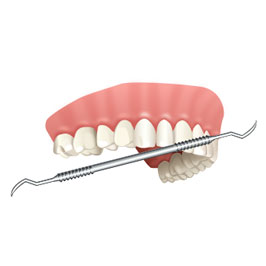
DENTAL CLEANING
A dental cleaning is a professional cleaning you receive from a dentist or dental hygienist. Most dental cleanings take only between 25 and 30 minutes. Cleanings should be performed every six months to prevent excessive plaque buildup. Plaque left untreated can lead to unhealthy gums and tooth decay. A routine dental cleaning should include scaling, root planing and polishing.
Scaling: This is the process of removing plaque and tartar from all tooth surfaces in a variety of methods, depending on the amount of plaque and tartar.
Dental hygienists traditionally perform scaling by hand. However, new and advanced technology has led to more modern methods such as electric scalers. This sophisticated tool allows dental cleanings to be performed more efficiently and in less time. To achieve best results, both electric and manual scaling methods are combined for dental cleanings.
« Return to Services List
PANORAMIC X-RAYS
This type of radiograph shows the whole jaw and is a good diagnostic tool. It is an important tool for the extraction of wisdom teeth, placement of dental implants, and for many orthodontic procedures. A panoramic radiograph will show any abnormal growths or cysts in the jaw. Panoramic radiographs are taken every three to five years or as needed for diagnostic purposes.
« Return to Services List
SNORE APPLIANCE
It is estimated that up to 50% of adults have some snoring disorder. Snoring is such a common problem; people tend to under-rate its seriousness. Disrupted sleep on an on-going basis can lead to relationship problems and affect the physical well being of both the snorer and partner alike.
What Causes Snoring?
When you’re asleep, the muscles and soft tissues in your throat and mouth automatically relax. The lower jaw and tongue drop back, helping block and decrease the airway opening. This results in an increase in the velocity of air flowing through your airway when you breathe. The increased velocity causes soft tissues in your mouth and throat to vibrate. That familiar snoring sound is actually the sound of those tissues vibrating.
In its most severe form, the collapse of the upper airway is so complete that the lungs may not receive oxygen for up to 30 seconds. This is called "Obstructive Sleep Apnea." In response to this deprivation of oxygen, your body triggers an internal alarm and you partially wake. This is usually accompanied by loud gasps for air that can last 3 seconds or more, until you fall asleep and the cycle starts all over again.
Snoring is also affected by diet, health, lifestyle, age, weight, environment and other factors.
A snore prevention appliance is a small oral device professionally fitted by a dentist. It has a unique inner lining that is softened by heat during the fitting process. (Similar to an athletic mouth guard.) The unit is custom fitted to your individual needs. It fits snugly over your top teeth while you sleep and is designed to prevent your tongue from dropping towards the back of your throat. This helps keep your airway open, effectively relieving the main cause of snoring.
« Return to Services List
SLEEP APNEA APPLIANCE
Sleep apnea is a common disorder in which you have one or more pauses in breathing or shallow breaths while you sleep.
Breathing pauses can last from a few seconds to minutes. They often occur 5 to 30 times or more an hour. Typically, normal breathing then starts again, sometimes with a loud snort or choking sound.
Sleep apnea usually is a chronic (ongoing) condition that disrupts your sleep 3 or more nights each week. You often move out of deep sleep and into light sleep when your breathing pauses or becomes shallow.
This results in poor sleep quality that makes you tired during the day. Sleep apnea is one of the leading causes of excessive daytime sleepiness.
« Return to Services List
NIGHTGUARDS
Custom designed nightguards are made of hard plastic and molded to fit the shape of your teeth. In addition, these guards protect the soft tissues of your tongue, lips and cheek lining. Nightguards are also recommended for patients who clench or grind their teeth at night as a way to protect their teeth and bite.
MOUTHGUARDS
Mouthguards are recommended to protect the jaw and teeth during physical activity and sports such as boxing, football, basketball, or other activities where your mouth may get hit.
If you have decided a guard is right for you, the dentist will take an impression of your teeth which will then be sent to a lab to make a custom fit guard for you. In most cases you can choose from a variety of colors and styles for your guard.
« Return to Services List
DIAGNOdent
Providing the absolute best service to our patients is of the highest importance to our office. To aid in achieving this goal, we use a new high-tech device called the DIAGNOdent. This small tool is a portable laser that allows us to detect cavities on the chewing surface of the back teeth that would have otherwise gone undetected by previous methods. Diagnosing cavities in the back of the mouth using traditional methods is difficult; studies even show that 50% of cavities are left undetected in these areas. However, the new DIAGNOdent enables us to locate and treat these cavities, putting a stop to further decay. The laser is easy to use, harmless, and will alert us with an audible signal if it detects a cavity. It will even calculate the approximate size of the cavity so we can better plan treatment. By using this device, you can rest assured that cavities will be accurately detected and treated in their infancy.
« Return to Services List
INVISALIGN
The Invisalign system works by first creating a series of trays that will each move your teeth gradually, until the end result is achieved.
« Return to Services List

ORAL HYGIENE CARE
Maintaining good oral hygiene is one of the most important things you can do for your teeth and gums. Healthy teeth not only enable you to look and feel good, they make it possible to eat and speak properly. Good oral health is important to your overall well-being.
Daily preventive care, including proper brushing and flossing, will help stop problems before they develop.
In between regular visits to the dentist, there are simple steps that each of us can take to greatly decrease the risk of developing tooth decay, gum disease and other dental problems. These include:
- Brush thoroughly twice a day and floss daily
- Eat a balanced diet and limit snacks between meals
- Use dental products that contain fluoride, including toothpaste
- Rinse with a fluoride mouth rinse if your dentist advises you to
- Make sure that your children under 12 drink fluoridated water or take a fluoride supplement if they live in a non-fluoridated area
« Return to Services List
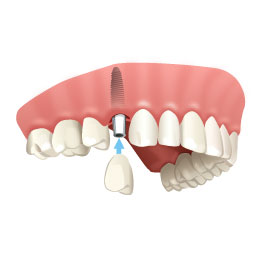
IMPLANT RESTORATION
A dental implant is an ideal tooth restoration for people who are missing one or more teeth as a result of injury, periodontal disease, or any other reason. A dental implant is a metal post that a periodontist, oral surgeon or general dentist surgically positions into the jaw. Once in place and bone surrounding the implant has had time to heal, a replacement tooth is attached to the post. While implants are typically more expensive than other methods of tooth replacement, they provide superior benefits. Implants are stronger than natural teeth and generally last 10-20 years. They are also a more favorable approach than bridgework since they do not depend on neighboring teeth for support.
To receive implants, you need to have healthy gums and adequate bone to support the implant. You must also be committed to excellent oral hygiene and regular dental visits as these are critical to the long-term success of dental implants.
« Return to Services List
LASER DENTISTRY
Laser dentistry is the latest advancement in dental technology, treating a wide range of dental and cosmetic problems from cavities to gum disease to teeth whitening. The lasers we use in laser dentistry at our practice are an alternative to the common hand-held scalpel, drills, or other tools. These lasers direct an invisible energy beam onto problem areas and allow us to efficiently treat decayed teeth, enamel, and gums. The benefit of laser dentistry is that they minimize the pain most often associated with dental procedures, meaning more comfort to our patients. Clinical studies show that approximately 96% of all patients require no anesthesia when lasers are being used during dental treatments. Dental lasers have been approved by the Food and Drug Administration and are safe for both adults and children.
Soft Tissue Laser
Soft tissue lasers are used to safely remove soft tissue, such as excess gum tissue. The soft tissue laser can also be employed to destroy bacteria in gum pockets, preventing infection and allowing the tissue to return to a healthy state. The soft tissue laser enables the dentist to treat our patients with extreme accuracy and eliminates the need for most stitches.
Hard Tissue Dental Laser
Hard tissue lasers are used to remove old fillings, repair cavities, and prepare teeth for bonding. As with soft tissue lasers, they dramatically minimize discomfort and allow the dentist to treat teeth with more precision.
« Return to Services List
DIGITAL PANORAMIC X-RAYS & INTRORAL X-RAYS
X-rays are a focused beam of x-ray particles passed through bone which produce an image on special film, showing the structure through which it passed. This provides the familiar black and white images doctors and dentists use to diagnose problems and disease. Without an x-ray of the whole tooth and supporting bone and gum tissues, there would be no way to detect infection or pathology that requires attention.
In our office we use digital radiography which allows us to take x-rays using up to 90% less radiation than conventional film x-rays. Using this technology, we are able to take an x-ray of your mouth. The result is a highly detailed image of your mouth that can easily be enhanced to better diagnose dental concerns and determine the very best treatment for each case.
« Return to Services List
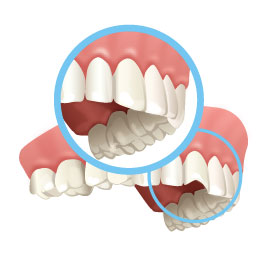
BONDING
Bonding is a conservative way to repair slightly chipped, discolored, or crooked teeth. During dental bonding, a white filling is placed onto your tooth to improve its appearance. The filling "bonds" with your teeth, and because it comes in a variety of tooth-colored shades it closely matches the appearance of your natural teeth.
Tooth bonding can also be used for teeth fillings instead of amalgam fillings. Many patients prefer bonding fillings because the white color is much less noticeable than the silver amalgam fillings. Bonding fillings can be used on front and back teeth depending on the location and extent of tooth decay.
Bonding is less expensive than other cosmetic treatments and usually can be completed in one visit to our office. However, bonding can stain and is easier to break than other cosmetic treatments such as porcelain veneers. If it does break or chip, tell your doctor. The bonding can generally be easily patched or repaired in one visit.
« Return to Services List
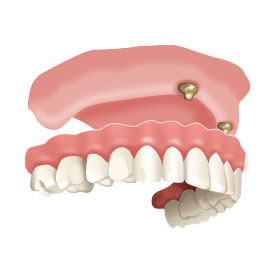
DENTURES
A denture is a removable replacement for missing teeth and surrounding tissues. There are two types of dentures available, including partial and complete dentures. Partial dentures are used when some natural teeth remain, while complete dentures are used to completely replace all teeth. Dentures are made to resemble your natural teeth so there should be no noticeable change to your appearance. In fact, dentures may even improve your smile!
Complete Dentures - This restoration method is used to restore your smile and mouth function if all your teeth have been lost. The dentures are custom created to resemble natural teeth and are positioned into a patient's mouth to take the place of where the natural teeth used to be. Complete dentures are removable and may require adjustments in order to create a proper fit with the gums and mouth.
Partial Dentures - A removable partial denture is a device used when one or more natural teeth still remain in the upper or lower jaw. They usually consist of replacement teeth attached to a gum-colored plastic base which is held in place in the mouth. A fixed partial denture acts the same as a removable denture, but it is cemented into place using the adjacent teeth for support. This fills the space created by missing teeth, as well as creates a support for remaining teeth to prevent shifting.
« Return to Services List
PAPERLESS CHARTING
Our office is a completely digital (paperless) dental office. This means all x-rays and charting are made and recorded with the aid of the computer. This technology allows us to maintain your dental records electronically, and cuts down the unnecessary paperwork used with traditional paper charting. Traditional paper charting is difficult to keep standardized from doctor to hygienist to assistant. Even handwriting differences and coding make the charts look different. The computer eliminates this problem by using consistent charting methods that are accurate and precise, making it easy to read your dental chart and see up-to-date information. Digital charting standardizes the charting process so it is clear, easy to understand, and enables us to provide on the most accurate and precise care to our patients. When needed, this method also allows us to quickly and securely share information with your other health care providers.
« Return to Services List
DIGITAL INTRAORAL X-RAYS
We use small cameras about the size of a pen, called intraoral cameras, to help clearly see the condition of your teeth and gums.
With this advanced technology we can zoom in on small diseased areas, cracks, chips and worn metal fillings with extreme precision. The full-color images taken with the intraoral camera are sent to a computer screen so we can clearly see and diagnose dental problems much earlier than with traditional dental technology. Because images are displayed on our screens, patients will also be able to see areas being worked on and are able to gain a better understanding of dental procedures being performed.
« Return to Services List
SEALANTS
Sealants are used to fill in narrow grooves in a tooth that cannot be adequately cleaned by brushing. In some cases, the tooth structure has fine grooves or pits which accumulate plaque, not because the person doesn't brush, but because they're too narrow to allow even one bristle into them. These will develop cavities over time, and you don't want that. So the dentist will brush on a coating that seals the grooves and pits, making it possible to brush off all the plaque and keep your teeth healthy.
« Return to Services List

WHITENING
Tooth whitening is a popular procedure to make teeth whiter and brighter, and therefore more attractive. Bleaching can be used to whiten stained and discolored teeth, or simply to enhance a dull smile. Either way, tooth whitening is a safe and relatively painless procedure ideal for most patients. Our office offers two methods of whitening: in-office whitening and tray whitening.
Tray whitening is a less expensive whitening treatment you can use while in the comfort of your own home to gradually whiten teeth. We will first take an impression of your teeth to create a customized clear tray that you will wear to whiten your teeth. Within a few days your trays will be ready to be picked up and we will show you how to apply the special bleaching material to the trays. The whitening gel trays should be worn 60-120 minutes up to twice a day. At the end of this period, you will see maximum whitening results that are nothing short of dazzling.
« Return to Services List
AUTOMATED APPOINTMENT REMINDER
We use an automated appointment reminder system that will call your home two days prior to your scheduled appointment time to remind you of your appointment. Please listen to the message carefully and press "1" to confirm the appointment and "2" if you wish to cancel. If you do not respond to the message, our office staff will contact you to confirm your scheduled visit. If are not home, a message will be left on your voicemail. Failure to notify our office of a cancellation may result in a charge. See our missed appointment policy for more information.
« Return to Services List
TELESCOPIC LOUPES
The dentist performs most of his dental procedures while wearing a pair of funny looking glasses called surgical telescopes. These powerful glasses have magnifiers on them, allowing the dentist to see fine details that would go unnoticed to the naked eye.
« Return to Services List
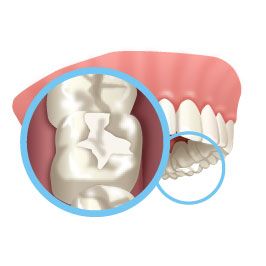
FILLINGS
A filling is a way to restore a tooth damaged by decay back to its normal function and shape. If you have a tooth that requires a filling, the dentist will first remove the decayed tooth material, clean the affected area, and then fill the cleaned out cavity with a filling material. A filling also helps prevent further decay by closing off any cracks or spaces where bacteria can enter.
There are a variety of filling materials available including gold, silver, plastic and porcelain. The dentist will work with you to determine which material is best for you, depending on the extent of repair, where in your mouth the filling is needed, and cost. Each of the filling materials is briefly explained below:
- Gold fillings are custom made in a laboratory and then cemented into place. While gold fillings are often the most expensive choice, many consider it the best filling material. Gold inlays are well-tolerated by gum tissues and may last more than 20 years.
- Amalgam (silver) fillings are a more inexpensive choice and are tolerant to wear. However, due to their dark color they are more noticeable than porcelain or composite restorations and are not recommended for fillings in very visible areas such as front teeth.
- Composite (plastic) resins are custom made to the exact color of your natural teeth, creating a more natural appearance. While white fillings may be less noticeable than other materials, they usually only last between 3 and 10 years. They may not be ideal for large fillings as they may chip or wear over time. They can also become stained from coffee, tea or tobacco.
- Porcelain fillings are called inlays or onlays and are custom created in a lab and then bonded to the tooth. They can be matched to the color of the tooth, resist staining, and are about the same cost as gold fillings. A porcelain restoration generally covers most of the tooth, making the filling nearly undetectable.
« Return to Services List
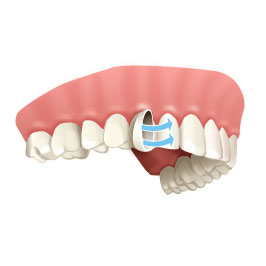
VENEERS
Veneers are a dental procedure in which a covering is placed over the outside (visible area) of the tooth. Veneers are usually only done to the part of the teeth that are visible when talking or smiling. The procedure can be direct or indirect.
The direct technique usually involves placing composite resin on the outside of the tooth using bonding. This method is usually referred to as bonding.
The indirect technique usually involves two appointments because the veneers will be fabricated at a dental laboratory. At the first appointment the teeth are prepared, impressions taken, and the teeth are given a temporary covering. In two to three weeks the veneers are back from the laboratory, the temporaries are removed and the veneers are bonded to the teeth. The laboratory fabricated veneers are usually made using porcelain or pressed ceramic, and are esthetically pleasing.
The advantage of veneers versus crowns is that much less tooth material is removed. Veneers are not recommended for teeth that have large fillings or little tooth structure.
« Return to Services List
DIGITAL IMAGING
We use digital imaging software in our office, which allows us to take a digital picture of you and use our imaging system to predict how a particular treatment or cosmetic procedure would change the appearance of your teeth. This software is beneficial for patients who are considering cosmetic procedures but are not sure if they're ready for dramatic changes. Digital imaging also allows us to document your dental case and procedures very well. We take digital images of your face, teeth and smile to provide us with a permanent dental record and to provide a visual documentation of treatment.
« Return to Services List
ELECTRONIC CLAIMS
Our office utilizes electronic claims processing. This means that rather than sending your dental claim through the mail, it is sent electronically to your insurance company with the click of the button. By filing your claim electronically, information is submitted more efficiently and with fewer errors. This benefits our patients because the turn around time on claims is faster and fewer claims are returned or denied. We are happy to submit your dental claims to your insurance company on your behalf.
« Return to Services List
CROWNS AND BRIDGES
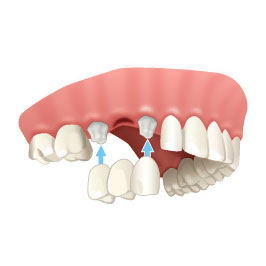
Crowns and bridges are used to restore and enhance teeth that are damaged, or to take the place of missing teeth. A crown, also referred to as a cap, is used to entirely cover a damaged tooth. A crown not only strengthens a tooth, but it can dramatically improve a tooth's appearance, shape and alignment.
Crowns may be used to:
- Replace a large filling when there is little tooth structure remaining
- Protect a weak tooth from fracturing
- Restore a fractured tooth
- Attach a bridge
- Cover a dental implant
- Cover a discolored or poorly shaped tooth
- Cover a tooth that has had root canal treatment
A bridge is an ideal method to fill the space created by missing teeth. A bridge is one or more artificial teeth that are cemented into place using the teeth on either side for support, hence the name. This is an option for filling the space created by a missing tooth. A bridge replaces the missing tooth, both functionally and cosmetically. Bridge work is as much an art as it is an exact science. The materials used may be gold alloys, porcelain bonded to metal alloy, or all ceramic material made to match your natural tooth color. The choice of material depends on requirements for strength, wear, and/or esthetics.
« Return to Services List
PERIODONTAL (GUM) TREATMENT
The gums, ligaments, and bone around the teeth form the foundation for one's teeth. All structures are also referred to as the periodontium. When the periodontium is not healthy, it jeopardizes the teeth just as a bad foundation would threaten the stability of a house. Signs of unhealthy periodontium include: gums that are red and bleed easily, persistent bad breath, gums that are pulled away from the tooth, loose teeth, and changes in the position or bite of the teeth. Any of these may be a sign of a problem. With proper gum treatments, however, it may be possible to return gum tissue to a healthy state. If you're having a problem, come in and see us so we may treat it right away. The treatment usually involves a deep cleaning or root planing done under a local anesthetic, along with local antibiotic agents. If the gum disease gets too severe it may need to be treated through surgery or extraction. This is why it is important to have it treated at the first sign of a problem.
« Return to Services List
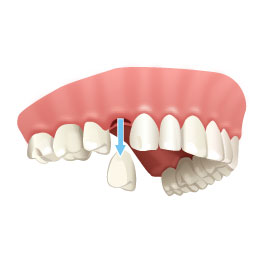
TOOTH EXTRACTIONS
Good oral hygiene should always be practiced since the loss of a single tooth can have major impact upon your oral health and appearance. Although dentists will use every measure to prevent tooth loss, there are still some occasions when a tooth may need to be extracted. A tooth may need to be extracted if the following occurs:
- Severe decay
- Advanced periodontal disease
- Infection or abscess
- Orthodontic correction
- Malpositioned teeth
- Fractured teeth or roots
- Impacted teeth
After careful examination and treatment, the dentist may advise to have a tooth extracted. Before a tooth is removed, the dentist will take an x-ray in order to understand the shape and position of the tooth and surrounding bone. Based on the degree of difficulty, we may refer you to a specialist called an oral surgeon.
A certain amount of discomfort may occur following an extraction, which can be minimized with certain medicines and ice packs applied to the face for 15 minutes at a time. After a routine extraction, discomfort should lessen within three days to two weeks. If you have prolonged or severe pain, swelling, bleeding or fever, call our office immediately.
« Return to Services List
ROOT CANAL TREATMENT
Root canal treatment (also referred to as root canal therapy or endodontic therapy) is made necessary when a cavity is allowed, through neglect, to reach all the way to the pulp. (Regular cleanings and checkups prevent and detect problems early) Sometimes deep restorations or trauma to a tooth may cause the nerve to be damaged to the point it needs root canal therapy, also. Once this occurs the pulp becomes infected, and can even extend through the root tip and begin to eat away at the surrounding bone (this is an abscess). By the time the pulp is infected it must be treated, and cannot heal on its own. It can even weaken the entire immune system. This is dangerous, not to mention very painful. Symptoms that the pulp has become infected may include sensitivity to hot/cold or sweets, pain, swelling, pain to biting or pressure, and a bad taste in the mouth.
Sometimes, however, no symptoms are apparent and the person is unaware of any problem until a checkup. A root canal is then performed to clean out the infected tooth pulp, and disinfect the canals of the tooth. The only other treatment would be to extract the tooth. Once the infection is resolved, the canal(s) are filled in to prevent any further infection. Usually a core build-up and crown is recommended for restoring a tooth that has had root canal therapy.
« Return to Services List
HALITOSIS
Halitosis is the sophisticated word for "bad breath". Depending on the cause, bad breath may strike on occasion or may be a more persistent condition. The most common cause of bad breath is bacteria. Because the mouth is moist and warm, it creates perfect conditions for the millions of bacteria that live in the mouth. In fact, approximately 80% of bad breath is caused by something in the mouth.
Bad breath caused by bacteria in the mouth can easily be treated. Brushing your teeth, tongue and gums after meals as well as flossing and rinsing with mouthwash will usually take care of the problem. Regular visits to the dentist should be made for dental examinations and for professional teeth and gum cleaning.
Some types of bad breath, such as "morning mouth," are considered fairly normal and are not usually health concerns. However, persistent bad breath may be a sign of more serious problems with the gums and teeth.
Bad breath may be caused by the following:
- Poor dental hygiene - poor oral hygiene can leave food particles to decay in the mouth
- Infections in the mouth such as periodontal (gum) disease
- Respiratory-tract infections such as throat infections, sinus infections, lung infections
- External agents including foods such as garlic, onions, and coffee, as well as cigarettes and chewing tobacco
- Dry mouth caused by salivary gland problems or by breathing through the mouth
- Systemic illnesses such as diabetes, liver disease, kidney disease, lung disease, sinus disease, reflux disease and others
Call our office promptly if you have bad breath with painful, swollen gums that bleed easily or loose teeth. We will perform a physical examination of your mouth to determine the cause. If we discover that systemic problems are the cause, we may refer you to your family physician. In severe cases of gum disease, we may recommend a doctor specialized to treat gum disease called a periodontist.
« Return to Services List
AIR ABRASION
Air abrasion is a drill-less and more gentle approach to remove decay from the teeth. An air abrasion unit is a small instrument that blasts a fine stream of air and particles onto the teeth to spray away decay. The small particles are made of silica, aluminum oxide or baking soda and aid in cleaning the tooth surface. Air abrasion allows for decay to quickly be removed while conserving healthy tooth structure. The particles and decay are then suctioned out of the mouth.
Air abrasion is gentle because it generates no heat, sound, pressure or vibration. In addition, it reduces the need for anesthesia, making it an ideal choice for children and those who experience dental anxiety.
« Return to Services List
TMJ TREATMENTS
TMJ stands for temporal-mandibular joint. Temporal, as in temple area of skull; mandibular as in mandible, or lower jaw; joint as in it's where the head and jaw meet. Problems in this joint may be caused by a misalignment of the teeth, trauma, or excess muscle tension. Aside from the two bones that meet there, cartilage buffers them and five muscles are involved in the area. If something goes wrong a good deal of trouble can result.
Problems in this area can cause:
- Headaches
- Earaches
- Trouble/soreness in opening and closing the mouth
- Clicking or popping of the jaw
- Pain in the jaw muscles
- Soreness in the area, sometimes extending to the face
Dental treatments for the condition can include replacing missing teeth, moving teeth, adjusting the bite, filling gaps between teeth, etc. There is no one solution that is right for all cases. Sometimes a plastic mouthpiece is used to prevent clenching or grinding that is contributing to the problem. If untreated and taken to extremes, surgery may be required to repair a badly damaged joint.
« Return to Services List
ORTHODONTICS
Orthodontics is the art of using appliances to straighten and align teeth. Most commonly it involves the use of braces to move teeth into their proper positing. In this method, brackets are bonded to the teeth and arch wires are threaded through the brackets. The arch wires act as a track, and guide each tooth to its proper position. There are several types of orthodontic braces available to consumers, including the more traditional metal braces, ceramic "tooth colored" braces, as well as clear plastic braces.
We also offer Invisalign. Click here to learn more »
« Return to Services List
CEREC
CEREC is an acronym for Charismatic Economical Restoration of Esthetic Ceramics. This high-tech equipment allows us to restore damaged teeth with beautiful custom ceramic crowns in a single visit, completely eliminating the need or multiple appointments over a several week period. The process can create a ceramic dental crown, inlays, onlays or veneers using a variety of technologies including 3D photography and computer-aided design and manufacturing known as CAD/CAM (see below). Using an intra-oral camera, a photograph is taken of the tooth and the picture is loaded onto the computer. Using Computer Aided Design technology, the dentist is able to design the restoration and transform the image into a three-dimensional model. This valuable program then allows the dentist to easily calculate the appropriate restoration shape and size to create near perfect restoration. When the model is ready, a milling machine then creates the restoration using a high-speed diamond bur and calculated precision. The restoration is then bonded to the tooth using a resin material. The result is a beautiful and custom designed and produced restoration, made entirely to fit your mouth. CEREC crowns are metal-free and have been used for over 20 years.
« Return to Services List
ORAL SEDATION
Dental sedation is a technique that can be used when a patient suffers from dental anxiety or dental phobia. We are happy to offer a number of solutions for our patients to make their dental visit as comfortable as possible. Sedation dentistry techniques enable patients - who might otherwise avoid the dentist - to receive dental treatment necessary for a healthy smile.
Depending on the extent of the anxiety or phobia, varying degrees of dental sedation can be utilized.
« Return to Services List
WISDOM TOOTH EXTRACTIONS
Wisdom teeth are the last molars, or "third molars" that develop on each side of the jaws. Wisdom teeth usually emerge in the back of the mouth between the ages of 16-20.
Wisdom teeth are a valuable asset to the mouth when they are healthy and properly positioned. Often, however, problems develop that require their removal. When the jaw isn't large enough to accommodate wisdom teeth, they can become impacted (unable to come in or misaligned). Wisdom teeth may grow sideways, emerge only part way through the gum or remain trapped beneath the gum and bone.
A wisdom tooth extraction is a relatively routine procedure. The dentist will numb the area in your mouth with a local anesthesia or use IV sedation so you are asleep during the procedure.
After the tooth (or teeth) is removed, you may be asked to bite down softly on a piece of gauze for 30 to 45 minutes after you leave the office, to limit any bleeding that may occur. Some pain and swelling may occur but it will normally go away after a few days; however, you should call your dentist if you have prolonged or severe pain, swelling, bleeding or fever.
« Return to Services List
COMPUTERIZED
Our office uses computerized shade matching to make restorations that perfectly match the color of your natural teeth. Old methods of shade matching can be inaccurate and inconsistent. Our shade matching system is a small hand-held device that captures tooth hue, value and chroma to create precise color matches. With this technology, you can be confident that your restorations will beautifully match your natural teeth.
« Return to Services List
AQUA ABRASION
Aqua abrasion is a new cutting and polishing systems that works in the same fashion as air abrasion. In addition to removing decay and preparing restorations, it can be used to effectively clean and polish the teeth through a fine stream of water that is sprayed onto the tooth surface. The aquabrasion system can replace the drill in many dental procedures and it quickly removes decay while conserving healthy tooth structure. Its gentle nature can eliminate the need for local anesthesia in many procedures.
« Return to Services List
CAD/CAM CHAIRSIDE RESTORATION SYSTEM
Our office utilizes CAD/CAM technology. CAD/CAM stands for "computer-aided design" and "computer-aided manufacturing". This technology allows the dentist to use an intra-oral scanner inside your mouth to take a digital scan of a tooth that has been prepared to receive a crown. Using special software, the data from the scan is used to generate a design (CAD) for a custom crown. This program will also generate a custom blue print and guide lines to manufacture the new crown (CAM). This software, paired with a state-of-the-art milling machine, enables our office to create precise and custom crowns, inlays and onlays in one single dental visit.
« Return to Services List
LUMINEERS
LUMINEERS® BY CERINATE® are porcelain veneers that offer the painless way to a permanently whiter and perfectly aligned smile. These contact lens-thin "smile shapers" can be applied to teeth without any grinding or shaving, transforming teeth into a naturally beautiful smile that looks perfect for every individual. LUMINEERS can even be placed over existing crown or bridgework without having to replace them.
Our team has taken numerous advanced training courses on this procedure. To see if you are a candidate, call our office for a complimentary consultation.
Click here to learn about LUMINEERS.« Return to Services List
BRIDGES
A bridge may be used to replace missing teeth, help maintain the shape of your face, and alleviate stress in your bite.
A bridge replaces missing teeth with artificial teeth, looks great, and literally bridges the gap where one or more teeth may have been. Your bridge can be made from gold, alloys, porcelain, or a combination of these materials and is bonded onto surrounding teeth for support.
The success of any bridge depends on its foundation — the other teeth, gums, or bone to which it is attached. Therefore, it's very important to keep your existing teeth, gums, and jaw healthy and strong.
« Return to Services List
CROWNS
Crowns are a cosmetic restoration used to improve your tooth's shape or to strengthen a tooth. Crowns are most often used for teeth that are broken, worn, or have portions destroyed by tooth decay.
Crowns are "caps" cemented onto an existing tooth which fully cover the portion of your tooth above the gum line. In effect, the crown becomes your tooth's new outer surface. Crowns can be made of porcelain, metal, or both. Porcelain crowns are most often preferred because they mimic the translucency of natural teeth and are very strong.
Crowns are often preferable to silver amalgam fillings. Unlike fillings which apply metal directly into your mouth, a crown is fabricated away from your mouth. Your crown is created in a lab from your unique tooth impression which allows a dental laboratory technician to examine all aspects of your bite and jaw movements. Your crown is then sculpted just for you so that your bite and jaw movements function normally once the crown is placed.
« Return to Services List
IMPLANTS
If you have missing teeth, it is crucial to replace them. Without all your teeth, chewing and eating can destabilize your bite and cause you discomfort. When teeth are missing, your mouth can shift and even cause your face to look older. Implants are a great way to replace your missing teeth.
An implant is a new tooth made of steel and porcelain that looks just like your natural tooth. Your implant is composed of two parts that mimic a tooth's root and crown. The implant's "root" is a titanium steel rod placed into the jaw bone to act as a root. Once the rod is in place, a porcelain crown is attached to replace the top part of your tooth.
Implants may also be used to anchor dentures, especially lower dentures that tend to shift when you talk or chew. Plus, for patients with removable partial dentures, implants can replace missing teeth so that you have a more natural-looking smile.

